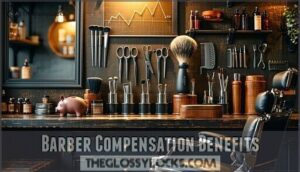This site is supported by our readers. We may earn a commission, at no cost to you, if you purchase through links.

The national average sits around $45,000, but top earners in bustling cities can pull in six figures, especially if they’ve built a loyal clientele or specialize in high-end services.
On the flip side, entry-level barbers or those in smaller towns might start closer to $20,000.
Tips and commissions can also boost your income substantially.
Want to maximize your earning potential? It’s all about sharpening your skills, finding your niche, and understanding your local market.
Table Of Contents
- Key Takeaways
- Barber Salary Overview
- How Much Do Barbers Make
- Factors Affecting Salary
- Barber Career Path
- Increasing Barber Earnings
- Barber Compensation Benefits
- Frequently Asked Questions (FAQs)
- Does a barber make a lot of money?
- Can you make 100k a year as a barber?
- How long does barber school take?
- How much does a barber make in Washington State?
- How much does a barber make a year?
- Does your salary matter in the Barber industry?
- Can a barber make 100k a year?
- How much does a Barber make?
- What are Top 10 Highest Paying Cities for Barber Jobs?
- How much does a Barber in United States make?
- Conclusion
Key Takeaways
- You can make anywhere from $26,000 to $60,000+ annually as a barber, with top earners hitting six figures by specializing in premium services and building a loyal clientele.
- Location matters—urban areas often pay more but come with higher living costs, while rural spots may offer lower salaries but less competition.
- Tips and commissions can significantly boost your income, adding 15-20% on top of your base salary.
- Sharpening your skills, finding a niche, and managing expenses are key strategies to maximize your earning potential.
Barber Salary Overview
You’re probably wondering exactly how much money you can make as a barber in 2025.
The national average salary ranges from $35,700 to $52,123 per year, but your actual earnings depend on several key factors including your location, experience level, and business model.
National Average Salary
The Bureau of Labor Statistics shows barber salaries paint a mixed picture across America.
Your earning potential depends on where you set up shop and how you position yourself in the market.
- National barber average income: $35,000 annually with significant regional variations
- Salary benchmarks: Range from $26,770 to over $50,000 based on income factors
- Cost comparison: Major cities offer higher pay but increased living expenses
Salary Range by Percentile
Your earning potential as a barber varies substantially across the salary distribution.
Bottom percentile earners start around $30,000 annually, while top earners in the 90th percentile reach $54,000.
This income inequality reflects differences in experience and location.
Most barber salaries fall between $31,000-$50,500, with barber income statistics showing steady growth potential as you develop your skills and clientele.
Highest and Lowest Paying Cities
Barber wages vary widely by location.
Urban areas like Chicago and San Francisco, with high client density and urban demand, offer top barber income, often exceeding $50,000 annually.
In contrast, cities like El Paso and Jackson, with lower cost living and regional economy challenges, see barber salaries dip to $25,000-$36,000.
Competition impact also shapes earnings substantially across regions, having a significant effect on the overall urban demand.
How Much Do Barbers Make
Barber earnings can vary widely, but understanding the numbers helps you plan better. On average, barber pay in 2025 is around $41,570 annually, or about $20 an hour.
Barbers in 2025 earn around $41,570 annually, proving skill and strategy can turn haircuts into thriving careers.
Barber wages typically range from $26,770 to $61,090 per year, depending on experience, location, and services offered. If you’re working full-time, barber annual salary estimates suggest you could make $40,000 or more, with top earners pulling in upwards of $60,000.
- Hourly barber wages range from $12 to $30, with an average of $20.
- Full-time barbers can expect daily earnings of $160 for an 8-hour day.
- Tips add 15-20% to barber pay, boosting overall income.
- Urban areas often offer higher barber salaries.
- Specializing in premium services increases earning potential.
Factors Affecting Salary
Your barber salary depends on more than just cutting skills; factors like location, experience, and business model play a big role.
Understanding these can help you plan for higher earnings and long-term success.
Experience and Skill Level
Your skill level and experience directly impact barber earnings. Mastering cutting techniques, offering advanced services, and improving product knowledge boost client retention and income.
Master your craft, elevate services, and watch your barber income grow with loyal clients and premium pricing.
Barber certifications signal expertise, helping you charge more. Experience builds trust, leading to loyal clients and higher barber salary potential.
Explore advanced barbering skills to refine your craft. Focus on honing skills to stand out—your barber income factors rely heavily on consistent growth and professionalism.
Location and Cost of Living
Where you work plays a big role in your barber salary.
Urban vs. rural areas show stark differences—city client rates are higher, but so is the cost of living.
Regional pay scales matter too; big cities often offer better pay.
Do a cost-benefit analysis before relocating for barber jobs.
Your location can make or break your barber career earnings.
Industry and Market Demand
In 2025, steady market growth and evolving client demographics keep barber jobs in high demand.
Men’s grooming trends and a growing competition landscape impact barber salary and job growth.
Here’s why demand stays strong:
- Essential grooming needs.
- Rising interest in premium services.
- Barber shortage in urban areas.
- Expanding service trends like beard care.
- Population growth sustaining barber employment outlook.
Business Model and Specialization
Your income hinges on your business model.
Chair rental offers independence but requires managing expenses, while commission splits provide stability, especially for beginners.
Specialization in niche services, like luxury grooming, boosts earnings by attracting premium clients.
Shop ownership adds control but demands more responsibility, and product sales during appointments can supplement income.
Making self-employment more lucrative with smart planning and efficient operations is key to success.
Barber Career Path
Your barber career path can start with an entry-level position and grow into owning your own shop or specializing in premium services.
With experience and skill, you’ll see better earnings and more opportunities in a growing industry.
Typical Career Progression
Starting in entry-level roles, you’ll focus on skill development and building a client base.
With experience, career advancement can include shop ownership or pursuing advanced certifications to boost earning potential.
Some barbers shift into instructor positions, sharing expertise while diversifying income.
Each step both increases your barber salary and strengthens your position in the growing barber job market.
Job Openings and Growth Prospects
Barber job growth is on the rise, with employment projected to grow 7% by 2033.
You’ll find about 89,100 job opportunities each year, thanks to industry evolution and increased demand.
Key factors shaping the job market include:
- Licensing impacts and regional requirements.
- Future demand for skilled professionals.
- Expanding career opportunities as barbering gains popularity.
Salary Increase With Experience
Experience shapes your earning trajectory as a barber.
Mastering advanced techniques and focusing on skill development boosts your barber salary range over time.
Client retention is key for career longevity and income maximization.
Here’s how experience impacts earnings:
| Experience Level | Hourly Wage | Annual Salary | Tips (Avg.) | Barber Income Potential |
|---|---|---|---|---|
| Entry-Level | $12 | $26,000 | 15% | Low |
| 1-3 Years | $18 | $37,500 | 18% | Moderate |
| 4-6 Years | $23 | $48,000 | 20% | High |
| 7-10 Years | $28 | $58,000 | 20%+ | Very High |
| 10+ Years | $30+ | $61,000+ | 20%+ | Excellent |
The table outlines the barber salary range and barber income potential based on experience level, with hourly wage and annual salary increasing as experience grows, ultimately leading to income maximization.
Increasing Barber Earnings
Boosting your barber income isn’t just about cutting more hair; it’s about working smarter.
By focusing on strategies like finding your niche, raising prices strategically, and managing expenses, you can maximize your earnings without overloading your schedule.
Finding a Niche and Building a Brand
Finding your niche boosts earnings by attracting loyal barber clients willing to pay premium pricing. A strong brand storytelling approach sets you apart.
Focus on niche services like scalp treatments or unique styles. Use social media engagement to showcase your skills and connect with potential clients.
A key element involves barber brand development.
- Highlight your expertise in niche services
- Share client transformations online
- Offer unique services
- Build client loyalty programs
- Leverage social media for growth
Implementing Referral Programs and Raising Prices
Referral programs boost client retention by rewarding loyal customers who bring in new ones.
Pair this with a smart pricing strategy to reflect your skills and offer premium pricing for high-demand services.
Highlight value perception by bundling services or offering add-ons.
These steps enhance barber income maximization, ensuring profit maximization while maintaining client loyalty and a steady flow of referrals.
Managing Expenses and Investing in Business
Raising prices is smart, but keeping more of what you earn matters too.
Manage your barber business by tracking expenses with accounting software and cutting unnecessary costs.
Focus on debt elimination and retirement planning to secure your future.
Smart investments, like better tools or training, can boost income.
Don’t forget insurance optimization—it protects your shop without breaking the bank.
Many barbers find value in specialized software options for their business.
Use expense tracking tools.
Prioritize debt elimination.
Invest in skills or equipment.
Barber Compensation Benefits
Understanding your compensation goes beyond just the base salary—it includes tips, bonuses, and other perks that can add up.
By planning for insurance, retirement, and savings, you can secure both your present income and future financial stability.
Base Salary and Total Cash Compensation
Barber salary is just the start—total cash compensation includes tips, commission structures, and rental fees.
While the average annual income ranges from $35,000 to $40,000, tips can add $150 daily.
Renting a chair costs $100-$300 weekly, but it boosts earning potential. Understanding barber income means balancing hourly wage with these factors to maximize your earning potential.
Professional Liability Insurance and Financial Planning
Protecting your career starts with insurance optimization. Professional liability insurance shields you from costly mistakes, ensuring financial security.
Pair this with smart financial planning—debt elimination frees up cash, while early investing grows your wealth.
Boost your earning potential by analyzing barber income tips and annual income trends. A solid plan keeps your barber income steady and stress-free.
Retirement Savings and Wealth Growth
Thinking ahead is key to building financial security. Alongside managing self-employment taxes, focus on early investing and debt elimination to free up funds.
Optimize expenses like back bar products and subscriptions to boost barber income potential. For future growth, diversify income streams and start retirement savings now.
Even small, consistent contributions can lead to substantial barber income growth. Start a retirement account early.
- Pay off high-interest debt quickly.
- Use barber income to invest in stocks or mutual funds.
- Budget for self-employment taxes to avoid surprises.
- Explore passive income options like product sales.
Frequently Asked Questions (FAQs)
Does a barber make a lot of money?
Making "a lot" depends on perspective.
Barbers can earn $26,000 to $60,000+ yearly, influenced by skills, location, and hours worked.
Specializing, raising prices, or owning a shop boosts income, but expenses cut into profits.
Can you make 100k a year as a barber?
Yes, you can hit $100k as a barber, but it takes strategy.
Focus on premium services, build loyal clients, work longer hours, and possibly own a shop.
Location and specialization also play huge roles.
How long does barber school take?
Barber school doesn’t take forever—it’s typically around 9 to 12 months.
Most programs last under a year, giving you the skills to start cutting hair and earning money without a massive time investment, which can be a significant advantage.
How much does a barber make in Washington State?
In Washington State, you can expect to earn around $38 per hour as a barber, with annual salaries ranging from $26,795 to $61,732 depending on experience, location, and clientele size.
How much does a barber make a year?
You can expect barbers to earn around $41,500 annually on average, though this varies widely. Entry-level positions might bring $26,000, while experienced barbers in prime locations could surpass $60,000, especially with specialized skills.
Does your salary matter in the Barber industry?
Like sharpening your scissors, your salary shapes your career’s edge.
It reflects your skills, location, and effort.
While income matters, building loyal clients, mastering techniques, and smart business choices ultimately determine your long-term success.
Can a barber make 100k a year?
Yes, you can make $100k as a barber.
It takes dedication—working long hours, specializing in premium services, building a loyal clientele, and possibly owning your shop.
Location and pricing strategy also play huge roles.
How much does a Barber make?
Barbers typically make around $41,500 annually, though earnings range from $26,000 to $60,000+. Hourly wages average $20, and factors like location, experience, and services offered can substantially impact your income potential.
What are Top 10 Highest Paying Cities for Barber Jobs?
Chicago, Saint Paul, Glendale, Denver, Kansas City, Columbia, Madison, Omaha, Pittsburgh, and Mobile top the list of highest-paying cities for barbers, with annual salaries ranging from $41,000 to over $48,
How much does a Barber in United States make?
Picture earning a steady income while shaping styles—barbers in the U.S. make an average of $41,570 annually.
Hourly rates range from $12 to $30, with top earners bringing in over $60,000 per year, which can be considered a steady income.
Conclusion
Think of your barber career like building a house—your income depends on the foundation you lay.
How much do barbers make in 2025? It varies widely, but focusing on skills, location, and specialization can push you toward the higher end of the scale.
Build a loyal client base, explore high-demand niches, and manage your business wisely.
Whether you’re just starting or aiming for six figures, success comes from adapting to your market and continually improving your craft.
- https://www.sofi.com/learn/content/how-much-does-a-barber-make/
- https://getsquire.com/business-edge/how-much-does-a-barber-make
- https://www.glassdoor.com/Salaries/barber-salary-SRCH_KO0,6.htm
- https://glossgenius.com/blog/how-much-do-barbers-make
- https://www.quora.com/How-much-did-you-make-as-a-barbershop-owner-in-your-first-year-after-opening-up-shop-How-many-clients-did-you-have-on-average-per-day-week-month












